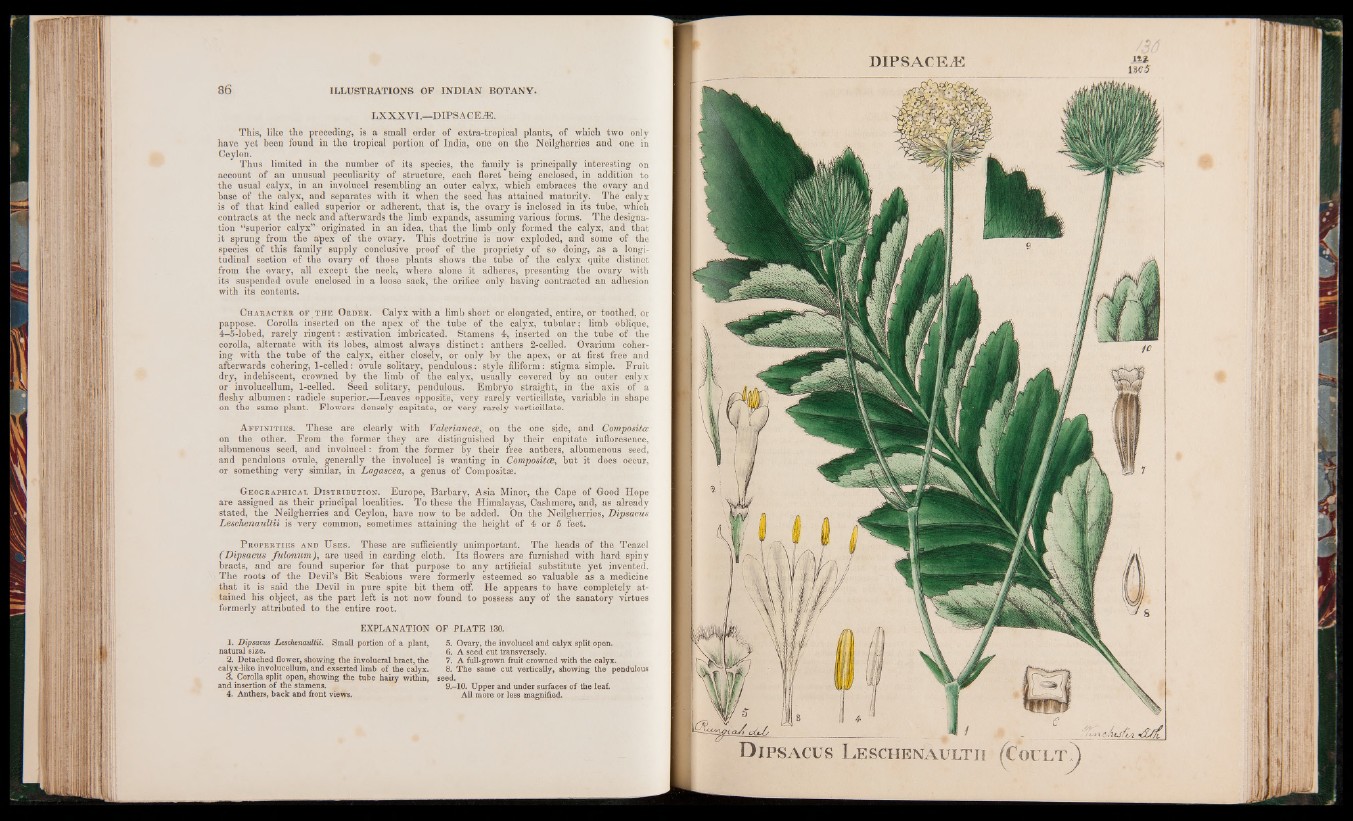
LXXX VI .—DIPS A CEiE.
This, like the preceding, is a small order of extra-tropical plants, of which two only
have yet been found in the tropical portion of India, one on the Neilgherries and one in
Ceylon.
Thus limited in the number of its species, the family is principally interesting on
account of an unusual peculiarity of structure, each floret being enclosed, in addition to
the usual calyx, in an involucel resembling an outer calyx, which embraces the ovary and
base of the calyx, and separates with it when the seed has attained maturity. The calyx
is of that kind called superior or adherent, that is, the ovary is inclosed in its tube, which
contracts at the neck and afterwards the limb expands, assuming various forms. The designation
“superior calyx” originated in an idea, that the limb only formed the calyx, and that
it sprung from the apex of the ovary. This doctrine is now exploded, and some of the
species of this family supply conclusive proof of the propriety of so doing, as a longitudinal
section of the ovary of those plants shows the tube of the calyx quite distinct
from the ovary, all except the neck, where alone it adheres, presenting the ovary with
its suspended ovule enclosed in a loose sack, the orifice only having contracted an adhesion
with its contents.
Character of the Order. Calyx with a limb short or elongated, entire, or toothed, or
pappose. Corolla inserted on the apex of the tube of the calyx, tubular; limb oblique,
4-5-lobed, rarely ringent: aestivation imbricated. Stamens 4, inserted on the tube of the
corolla, alternate with its lobes, almost always distinct: anthers 2-celled. Ovarium cohering
with the tube of the calyx, either closely, or only by the apex, or at first free and
afterwards cohering, 1-celled: ovule solitary, pendulous: style filiform: stigma simple. Fruit
dry, indehiscent, crowned by the limb of the calyx, usually covered by an outer calyx
or involucellum, 1-celled. Seed solitary, pendulous. Embryo straight^ in the axis of a
fleshy albumen: radicle superior.—Leaves opposite, very rarely verticillate, variable in shape
on the same plant. Flowers densely capitate, or very rarely—verticillate.
Af f in it ies . These are clearly with Valerianece,, on the one side, and Composites
on the other. From the former they are distinguished by their capitate iufloresence,
albumenous seed, and involucel: from the former by their free anthers, albumenous seed,
and pendulous ovule, generally the involucel is wanting in Compositce, but it does occur,
or something very similar, in Lagascea, a genus of Composite,
Geographical Distribution. Europe, Barbary, Asia Minor, the Cape of Good Hope
are assigned as their principal localities. To these the Himalayas, Cashmere, and, as already
stated, the Neilgherries and Ceylon, have now to be added. On the Neilgherries, Dipsacus
Leschenaultii is very common, sometimes attaining the height of 4 or 5 feet.
P roperties and U ses. These are sufficiently unimportant. The heads of the Teazel
(Dipsacus fulonum), are used in carding cloth. Its flowers are furnished with hard spiny
bracts, and are found superior for that purpose to any artificial substitute yet invented.
The roots of the Devil’s Bit Scabious were formerly esteemed so valuable as a medicine
that it is said the Devil in pure spite bit them off. He appears to have completely attained
his object, as the part left is not now found to possess any of the sanatory virtues
formerly attributed to the entire root.
EXPLANATION OF PLATE 130.
1. Dipsacus Leschenaultii. Small portion of a plant,
natural size.
2. Detached flower, showing the involucral bract, the
catyx-like involucellum, and exserted limb of the calyx.
3. Corolla split open, showing the tube hairy within,
and insertion of the stamens.
4. Anthers, back and front views.
5. Ovary, the involucel and calyx split open.
6. A seed cut transversely.
7. A full-grown fruit crowned with the calyx.
8. The same cut vertically, showing the pendulous
seed.
9. -10. Upper and under surfaces of the leaf.
All more or less magnified.
d i p s a c e ^e M2 UeS